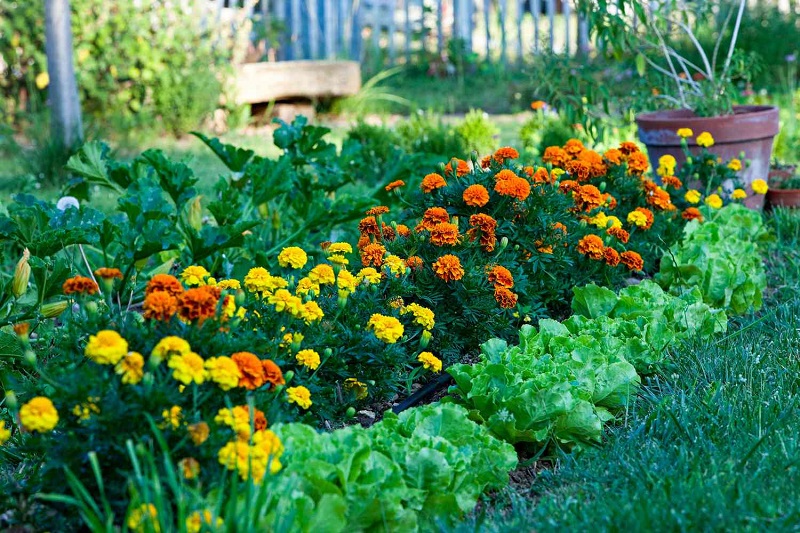Why choose between a pretty garden and a productive one when you can have both?
From vibrant veg to herbs that flirt with your senses, it’s style and substance all in one.
With the right touch, your garden becomes the tastiest part of your home.
Flavour and Freshness Without Compromise
Supermarket fruit may look flawless, but the flavour often leaves much to be desired.
Rows of identical bananas and cucumbers the size of your forearm might be easy on the eye, but they’re usually the product of mass farming, synthetic feeds, and chemical sprays.
The result? Picture-perfect produce that’s oddly bland.
Homegrown food, on the other hand, tells a different story. Each tomato, slightly misshapen and warm from the sun, is a burst of summer on the tongue.
The herbs you clip just before dinner carry a vibrancy no plastic packet can match. Not only do you get better food when you grow your own, but you also develop a closer bond with the food you consume.
From seed to plate, the entire process is in your hands. That is both empowering and fulfilling.
Convenience and Savings Close to Home
Imagine padding out to your garden in your slippers, coffee in one hand, scissors in the other, to harvest lunch. No traffic, no queues, no wilting lettuce in a plastic bag—just crisp, fragrant leaves at your fingertips.
Besides the sheer convenience, the savings add up quickly. Organic produce in shops often comes with a price tag that makes your eyes water. But in your own back garden? It’s yours for the cost of a seed packet and a bit of care.
In addition to saving money, this type of setup also frees up time. You’ll spend fewer weekends darting between shops and more moments savouring food that tastes as it should.
Quite impressive for a simple patch of earth outside your door.
And for keen cooks, there’s something special about crafting meals around what’s in season and ripe.
You’re no longer tied to best-before dates or imported produce but instead guided by nature’s gentle calendar.
Wildlife and Sustainability in Harmony
Edible gardens have a way of attracting all the right guests.
Bees buzz in happily, butterflies flit through the foliage, and birds drop by for a chat. While you’re growing your dinner, you’re also supporting the very creatures that keep our ecosystems ticking along.
There’s a subtle eco-magic to it all. Many native or drought-tolerant plants thrive with minimal fuss, conserving water without sacrificing beauty.
These plants also help stabilise soil, reduce erosion, and promote healthier growing conditions for nearby crops. Interplanting flowers with edibles can even boost pollination and naturally repel pests, making your space both beautiful and functional.
What’s more, edible gardens can offer surprising resilience in the face of changing weather patterns.
With careful plant selection and thoughtful layout, they can withstand heatwaves, heavy rain, and even late frosts better than conventional lawns or delicate ornamentals.
This makes them not only practical but also well-suited for a future where climate unpredictability is the new normal.
With only the gentle rustle of leaves and the satisfying crunch of fresh veg, there’s little need for irrigation and no single-use plastic containers.
And when your dinner comes from five steps away rather than five thousand miles, that’s a little win for the climate every single day.
You’re also likely to waste less. When food is grown within reach, there’s a deeper sense of appreciation, and that often leads to more thoughtful harvesting, cooking, and preserving.
Space and Conditions That Shape Success
Before you rush out with a trowel and grand ambitions, take a step back. A well-designed edible garden begins with observation.
Notice where the sun lingers longest and where the shade settles in. Does your soil drain well? Which spots stay damp after rain? These details will shape your planting decisions more than any Pinterest board ever could.
Some plants, like tomatoes and courgettes, crave full sun. Others, such as chard and parsley, are perfectly happy in partial shade.
Watering needs vary too. For instance, lavender barely needs a drink, while lettuce can be quite the thirsty customer.
Be sure to measure your space properly before buying anything. It’s easy to get carried away and end up with a jungle instead of a garden. Matching the right plants to the right spots is what turns chaos into harmony.
Also, keep in mind accessibility. Think about how easily you can reach herbs near the kitchen, or whether taller crops cast shade on smaller neighbours.
In the end, good planning makes for good picking.
Structure and Style With Edible Charm
Edible gardens are more than just practical—they can be downright beautiful. With a little thought, your plot can delight the eyes as much as the taste buds.
Do you want something formal and refined? Raised beds with clipped herbs like thyme and lavender can lend a stately air.
Fruit trees, especially apple or lemon, make glorious centrepieces, offering structure and shade along with seasonal bounty. Even something as humble as ornamental lettuce can become a showstopper, thanks to its deep hues and sculptural form.
If your heart leans more towards whimsy, take a leaf from the cottage garden playbook.
Let cherry tomatoes sprawl and chives self-seed. Add a sprinkling of edible flowers like pansies or nasturtiums for bursts of colour and a hint of drama on the plate.
For those looking to truly elevate their garden’s charm and cohesion, working with landscape companies that specialise in edible design can be an inspired move.
They know how to balance form and function, so the result feels both natural and intentional, an outdoor space that feeds you in every sense.
Care with Confidence, Harvest with Pride
Tending an edible garden doesn’t have to feel like a full-time job. With a smart routine and a bit of know-how, it becomes second nature.
Start with water. Each plant has its preferences, so resist the urge to drench everything at once.
Drip irrigation systems are excellent because they minimise waste, keep leaves dry, and deliver water directly to the roots, which is a great defence against mould and mildew.
Then there’s the matter of pests. While it’s true that unwanted visitors will pop in, there’s no need to panic. Simple traps or lightweight covers can keep the worst offenders out.
And don’t forget the helpers. Ladybirds, frogs, and birds can become part of your garden’s unofficial security team, keeping pests in check without harsh chemicals.
Soil, too, deserves a bit of love. Feeding it twice a year with compost, crushed eggshells, or even leftover coffee grounds can do wonders for fertility. Spring and late summer are ideal times to give your soil a boost, setting your plants up for success all year round.
Finally, there’s harvesting. It’s a step in the process, not just the result.
Pick herbs in the morning before they flower, gather greens before they turn bitter, and watch for signs of ripeness in fruit—full colour, gentle give, and a fragrance that practically says, “I’m ready.”
Regular picking encourages more growth, so your garden keeps giving long after the first harvest.
Conclusion
An edible garden isn’t just a source of sustenance; it’s a place of purpose and quiet creativity.
With every harvest, you’re not only feeding yourself but building something personal, beautiful, and ever-changing.
So dig in, plant with heart, and watch your garden bloom into a space that nourishes both body and soul.

